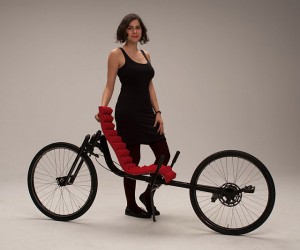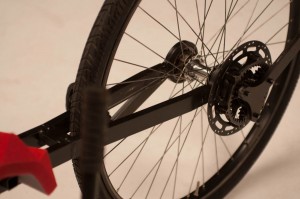 Mohsen Saleh, a design engineer living in Milan, Italy, has been working on a rear wheel steering recumbent bike design (in his spare time) for about a year. In a recent post on his blog, Mohsen explained his three main objectives for the project:
Mohsen Saleh, a design engineer living in Milan, Italy, has been working on a rear wheel steering recumbent bike design (in his spare time) for about a year. In a recent post on his blog, Mohsen explained his three main objectives for the project:
- To eliminate the long chains used on current recumbent bikes
- To eliminate interference of legs with the steering front wheel
- To design a recumbent bike with more potential for use in urban environments (a bike that is easier to stop and start, considering constant traffic interruption in cities)
 Just recently, he built his first prototype of his design, which in addition to rear wheel steering, features a planetary hub gear in the front wheel. Check out his post for more information about the bike and its transmission, and see this video showing the prototype construction and the steering and gearing systems at work. You can also find additional photos of his prototype here. Prior to his RWS bike design, Mohsen worked on a lean steer trike with a similar planetary gear system, so take a look at his post about that project as well.
Just recently, he built his first prototype of his design, which in addition to rear wheel steering, features a planetary hub gear in the front wheel. Check out his post for more information about the bike and its transmission, and see this video showing the prototype construction and the steering and gearing systems at work. You can also find additional photos of his prototype here. Prior to his RWS bike design, Mohsen worked on a lean steer trike with a similar planetary gear system, so take a look at his post about that project as well.
As you probably know, designing a stable rear wheel steering bike is a difficult task, and Mohsen covers a few of his design challenges in the post. He points out that his prototype, while rideable, is a bit wobbly, and he lists a few known issues that he wants to fix with his next design. He is also looking for feedback from anyone with experience designing a RWS bike. If you wish to offer any input that might help him with his second prototype, leave a comment here, at his post, or contact him through his blog.

Leave a Reply to Mike Cancel reply